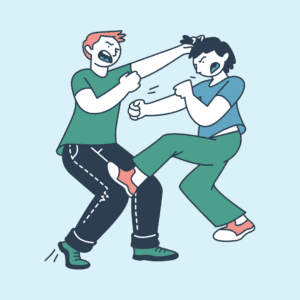Small group counseling can be a useful and effective intervention in a school counselor’s repertoire. But, woah can they be challenging to organize and run at first. With over 100 years of practice between all of us, we figured some of our tested tips would be mighty handy as you are beginning or considering your groups. Please contribute some of your tips in the comments below so we all walk more confidently into that room of five defiant third grade boys needing some support with impulse control.
Organizing Small Group Counseling
Group Size
Don't be tempted to make large group sizes in order to allow more students in a group. Think about your space, the personalities and behaviors of the students in the group and the activities planned.
Be careful of group size, you can easily lose effectiveness if you try to include too many students at once.
Picking Students
Screen potential group members before placement. Group participants need to see how the experience will benefit them and should be willing to work to accomplish a goal.
While planning your groups, be sure to think about the dynamic of your group participants. Disruptive behavior can quickly sink a group lesson and make 30 minutes seem like 30 hours.
Students, who exhibit extremely disruptive behavior, can benefit greatly from small groups with 3-4 group members. Smaller groups allow you to provide more structure and positive reinforcement, thus making your groups more engaging and effective!
Instead of grouping kids by class or gender, I group them by issue and (usually but not always) grade. Types of groups I run every trimester include: anxiety, Zones of Regulation, Social Thinking, and positive thinking/CBT. Others I've done have been focused on grief, mindfulness, divorce, incarcerated parents, and service learning (for kids who need to develop self-esteem and/or empathy).
Keep groups time-limited (e.g., 8 weeks) and firmly focused on skill development, practice, and reinforcement. Communicate key strategies to teachers and adults to encourage generalization across settings.
Groups can be the most efficient use of your direct service time. However, there will certainly be students for whom group counseling will be contraindicated: kids with serious trauma, those with severe attentional or behavioral issues, or those who won't be able to understand or respect rules of confidentiality.
Get Your System Down
Use Google Docs to help you plan, organize, and schedule your small group sessions. Print out a schedule of the days, times, and students in each small group and give the schedule to each student's teacher in advance to help with organization.
Create a counseling permission form that includes
- the group title (ex, New Friends Club),
- the frequency and duration of group meetings,
- three options for parent to check (Yes please, No thanks, I'd like to know more),
- student and parent contact info,
- parent signature and date line.
Use the form to group kids and initiate sessions.
- put a form in every new student registration packet,
- file away forms marked 'no',
- begin groups with those marked 'yes',
- follow up with parents who requested 'more info'
Identify clear, measurable session objectives and keep measurement forms handy during/after session for quick assessment.
Keep group materials organized by printing all session materials before starting your group. I like to store all materials for each session in separate page protectors inside a binder to maintain organization!
Running Small Group Counseling
Routines
Establishing group rules and norms is vital to the success of a small group. Students must feel safe in order to be authentic with the group.
Include group confidentiality rules and give specific examples for clarity. Have students help set up the norms so that they are more likely to buy into the process.
Finally, model appropriate group behavior and redirect when needed. I feel like this is the most important step for a successful group outcome.
During the first few minutes of a session, ask if anyone wants to discuss anything on their mind or from the previous week. In school settings, this is also a good time to address any discipline or academic problems that might have occurred with a group member in the last week. Try to keep these discussions to no more than 5–10 minutes so as to not focus the entire session on them.
I maintain a similar structure for all of my groups that I facilitate during lunch. I labeled a shoe holder with feelings posters, and each student places their "feelings card" in the pocket as they arrive. This allows us to give other students more time to get through the lunch line, and it gets students thinking about emotions.
I follow this up with a "good news/bad news" group share, and students have the opportunity to share more about how they are feeling. It's great practice for feelings identification and expression, and it helps develop group rapport. It's quick and easy to do, and the consistency of the structure provides the students with a sense of security.
I used a predictable schedule for groups that helped students know what to expect and helped me with planning. We started with a fun greeting, a five minute mini lesson, guided practice of target skills, and an activity/game to practice the skill more independently. Last, I'd have a quick exit ticket or whip around. I also give the kids roles, like time keeper, to keep us all focused.
Group Development
Always leave some extra time at the end of your group session! You do not want students to bond and disclose, then have to rush back to class! This allows students to talk to you individually, gather themselves, and/or for YOU to reboot for your next session! I give myself at least 5 -10 minutes so I can write down my session notes as well. This bit of time is everything!
Traci ‧ College Counselor Traci
In the early group stages, avoid unnecessary power struggles by being mindful that anxiety is masked with resistance, goofiness, and defiance. Regardless of the group topic, to ensure trust is built and maintained, consistently provide feelings check ins, validate, acknowledge the group process, and address minor interpersonal conflicts on the spot. Empower the students to problem solve as a group. A sign you are leading a group successfully is when the students are using each other for support and feedback
Spend the first couple sessions doing activities that help build trust among group members. Trust is key. The more group members trust one another, the more they will open up and share.
How do you organize and run Small groups?
Share your tips below!





